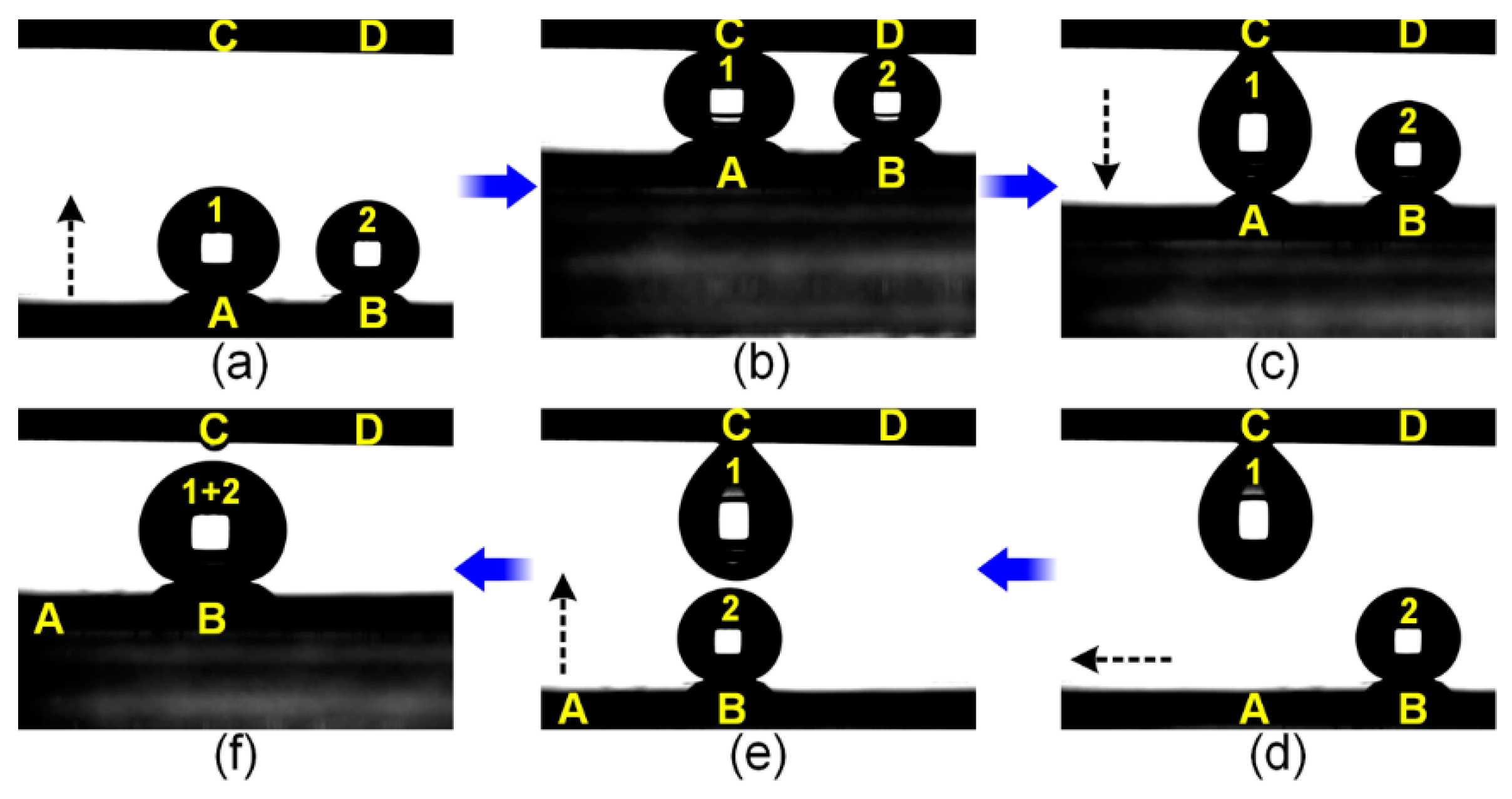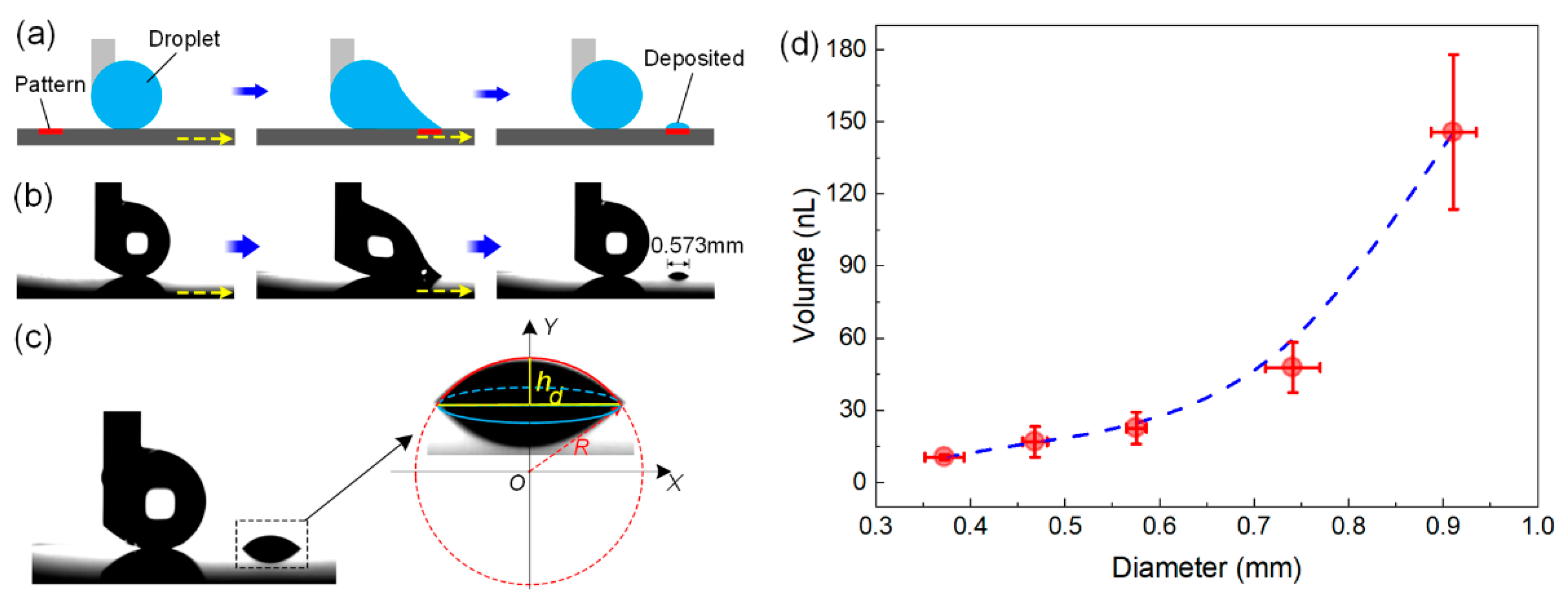Submitted:
18 January 2024
Posted:
19 January 2024
You are already at the latest version
Abstract
Keywords:
1. Introduction
2. Materials and Methods
3. Results and discussion
4. Conclusions
Author Contributions
Funding
Data Availability Statement
Acknowledgments
Conflicts of Interest
References
- Wang, D.; Sun, Q.; Hokkanen, M.J.; Zhang, C.; Lin, F.Y.; Liu, Q.; Zhu, S.P.; Zhou, T.; Chang, Q.; He, B.; Zhou, Q.; Chen, L.; Wang, Z.; Ras, R.H.A.; Deng, X. Design of robust superhydrophobic surfaces. Nature 2020, 582, 55–59. [Google Scholar] [CrossRef]
- Sun, D.; Bohringer, K.F. Self-Cleaning: From Bio-Inspired Surface Modification to MEMS/Microfluidics System Integration. Micromachines 2019, 10, 101. [Google Scholar] [CrossRef]
- Su, W.; Lu, X.; Shu, Y.; Liu, X.; Gao, W.; Yao, J.; Niu, Z.; Xie, Y. Robust, Superhydrophobic Aluminum Fins with Excellent Mechanical Durability and Self-Cleaning Ability. Micromachines 2023, 14, 704. [Google Scholar] [CrossRef]
- Xu, T.; Xu, L.P.; Zhang, X.; Wang, S. Bioinspired superwettable micropatterns for biosensing. Chem. Soc. Rev. 2019, 48, 3153–3165. [Google Scholar] [CrossRef]
- Wang, L.; Wu, Y.; Li, G.; Xu, H.; Gao, J.; Zhang, Q. Superhydrophobic n-octadecylsiloxane (PODS)-functionalized PDA-PEI film as efficient water-resistant sensor for ppb-level hexanal detection. Chem. Eng. J. 2020, 399, 125755. [Google Scholar] [CrossRef]
- Song, J.; Cheng, W.; Nie, M.; He, X.; Nam, W.; Cheng, J.; Zhou, W. Partial Leidenfrost Evaporation-Assisted Ultrasensitive Surface-Enhanced Raman Spectroscopy in a Janus Water Droplet on Hierarchical Plasmonic Micro-/Nanostructures. ACS Nano 2020, 14, 9521–9531. [Google Scholar] [CrossRef] [PubMed]
- Li, H.; Yang, Q.; Hou, J.; Li, Y.; Li, M.; Song, Y. Bioinspired Micropatterned Superhydrophilic Au-Areoles for Surface-Enhanced Raman Scattering (SERS) Trace Detection. Adv. Funct. Mater. 2018, 28, 1800448. [Google Scholar] [CrossRef]
- Zhao, Z.; Qin, S.; Wang, D.; Pu, Y.; Wang, J.-X.; Saczek, J.; Harvey, A.; Ling, C.; Wang, S.; Chen, J.-F. Multi-stimuli-responsive liquid marbles stabilized by superhydrophobic luminescent carbon dots for miniature reactors. Chem. Eng. J. 2020, 391, 123478. [Google Scholar] [CrossRef]
- Yu, C.; Zhu, X.; Cao, M.; Yu, C.; Li, K.; Jiang, L. Superhydrophobic helix: controllable and directional bubble transport in an aqueous environment. J. Mater. Chem. A 2016, 4, 16865–16870. [Google Scholar] [CrossRef]
- Li, Q.; Guo, Z.G. Fundamentals of icing and common strategies for designing biomimetic anti-icing surfaces. J. Mater. Chem. A 2018, 6, 13549–13581. [Google Scholar] [CrossRef]
- Yang, C.; Chao, J.; Zhang, J.; Zhang, Z.; Liu, X.; Tian, Y.; Zhang, D.; Chen, F. Functionalized CFRP surface with water-repellence, self-cleaning and anti-icing properties. Colloids Surf., A 2020, 586, 124278. [Google Scholar] [CrossRef]
- Vercillo, V.; Tonnicchia, S.; Romano, J.-M.; García-Girón, A.; Aguilar-Morales, A.I.; Alamri, S.; Dimov, S.S.; Kunze, T.L. Andrés Fabián; Bonaccurso, E. Design Rules for Laser-Treated Icephobic Metallic Surfaces for Aeronautic Applications. Adv. Funct. Mater. 2020, 30, 1910268. [Google Scholar] [CrossRef]
- Zhang, L.; Chu, X.; Tian, F.; Xu, Y.; Hu, H. Bio-Inspired Hierarchical Micro-/Nanostructures for Anti-Icing Solely Fabricated by Metal-Assisted Chemical Etching. Micromachines 2022, 13, 1077. [Google Scholar] [CrossRef]
- Li, Z.; Wang, X.; Bai, H.; Cao, M. Advances in Bioinspired Superhydrophobic Surfaces Made from Silicones: Fabrication and Application. Polymers 2023, 15, 543. [Google Scholar] [CrossRef] [PubMed]
- Chen, F.; Lu, Y.; Liu, X.; Song, J.; He, G.; Tiwari, M.K.; Carmalt, C.J.; Parkin, I.P. Table salt as a template to prepare reusable porous PVDF–MWCNT foam for separation of immiscible oils/organic solvents and corrosive aqueous solutions. Adv. Funct. Mater. 2017, 41, 1702926. [Google Scholar] [CrossRef]
- Xia, L.; Chen, F.; Cai, Z.; Chao, J.; Tian, Y.; Zhang, D. Magnet-assisted selective oil removal from water in non-open channel and continuous oil spills clean-up. Sep. Purif. Technol. 2022, 282, 120119. [Google Scholar] [CrossRef]
- Liu, H.; Zhang, Z.; Wu, C.; Su, K.; Kan, X. Biomimetic Superhydrophobic Materials through 3D Printing: Progress and Challenges. Micromachines 2023, 14, 1216. [Google Scholar] [CrossRef]
- Zhu, Z.; Li, J.; Peng, H.; Liu, D. Nature-Inspired Structures Applied in Heat Transfer Enhancement and Drag Reduction. Micromachines 2021, 12, 656. [Google Scholar] [CrossRef]
- Cho, H.J.; Preston, D.J.; Zhu, Y.; Wang, E.N. Nanoengineered materials for liquid-vapour phase-change heat transfer. Nat. Rev. Mater. 2016, 2, 16092. [Google Scholar] [CrossRef]
- Miljkovic, N.; Wang, E.N. Condensation heat transfer on superhydrophobic surfaces. MRS Bull. 2013, 38, 397–406. [Google Scholar] [CrossRef]
- Feng, J.; Chen, F.; Chao, J.; Cai, Z.; Liu, T.; Zhang, D.; Tian, Y. Anti-corrosion property of superhydrophobic copper mesh with one-step self-assembled perfluorothiolate monolayers. Surf. Interface Anal. 2022, 54, 1087–1097. [Google Scholar] [CrossRef]
- Zhang, L.; Tan, Z.; Zhang, C.; Tang, J.; Yao, C.; You, X.; Hao, B. Research on Metal Corrosion Resistant Bioinspired Special Wetting Surface Based on Laser Texturing Technology: A Review. Micromachines 2022, 13, 1431. [Google Scholar] [CrossRef] [PubMed]
- Zhang, D.; Wu, G.; Li, H.; Cui, Y.; Zhang, Y. Superamphiphobic surfaces with robust self-cleaning, abrasion resistance and anti-corrosion. Chem. Eng. J. 2021, 406, 126753. [Google Scholar] [CrossRef]
- Tian, X.L.; Verho, T.; Ras, R.H.A. Moving superhydrophobic surfaces toward real-world applications. Science 2016, 352, 142–143. [Google Scholar] [CrossRef]
- Zhang, W.; Wang, D.; Sun, Z.; Song, J.; Deng, X. Robust superhydrophobicity: mechanisms and strategies. Chem. Soc. Rev. 2021, 50, 4031–4061. [Google Scholar] [CrossRef]
- Chen, F.; Wang, Y.; Tian, Y.; Zhang, D.; Song, J.; Crick, C.R.; Carmalt, C.J.; Parkin, I.P.; Lu, Y. Robust and durable liquid-repellent surfaces. Chem. Soc. Rev. 2022, 51, 8476–8583. [Google Scholar] [CrossRef]
- Pan, S.; Kota, A.K.; Mabry, J.M.; Tuteja, A. Superomniphobic surfaces for effective chemical shielding. J. Am. Chem. Soc. 2013, 135, 578–581. [Google Scholar] [CrossRef]
- Wei, D.; Wang, J.; Liu, Y.; Wang, D.; Li, S.; Wang, H. Controllable superhydrophobic surfaces with tunable adhesion on Mg alloys by a simple etching method and its corrosion inhibition performance. Chem. Eng. J. 2021, 404, 126444. [Google Scholar] [CrossRef]
- Li, Y.; Zhang, X.G.; Cui, Y.X.; Wang, H.Y.; Wang, J.X. Anti-corrosion enhancement of superhydrophobic coating utilizing oxygen vacancy modified potassium titanate whisker. Chem. Eng. J. 2019, 374, 1326–1336. [Google Scholar] [CrossRef]
- Chen, F.; Xu, W.; Lu, Y.; Song, J.; Huang, S.; Wang, L.; Parkin, I.P.; Liu, X. Hydrophilic patterning of superhydrophobic surfaces by atmospheric-pressure plasma jet. Micro Nano Lett. 2015, 10, 105–108. [Google Scholar] [CrossRef]
- Chen, F.; Liu, J.; Cui, Y.; Huang, S.; Song, J.; Sun, J.; Xu, W.; Liu, X. Stability of plasma treated superhydrophobic surfaces under different ambient conditions. J. Colloid Interface Sci. 2016, 470, 221–228. [Google Scholar] [CrossRef] [PubMed]
- Ghosh, A.; Ganguly, R.; Schutzius, T.M.; Megaridis, C.M. Wettability patterning for high-rate, pumpless fluid transport on open, non-planar microfluidic platforms. Lab Chip 2014, 14, 1538–1550. [Google Scholar] [CrossRef] [PubMed]
- Xu, T.; Shi, W.; Huang, J.; Song, Y.; Zhang, F.; Xu, L.-P.; Zhang, X.; Wang, S. Superwettable Microchips as a Platform toward Microgravity Biosensing. ACS Nano 2017, 11, 621–626. [Google Scholar] [CrossRef] [PubMed]
- Chen, F.; Xu, W.; Huang, S.; Liu, J.; Song, J.; Liu, X. Plasma hydrophilization of superhydrophobic surface and its aging behavior: the effect of micro/nanostructured surface. Surf. Interface Anal. 2016, 6, 368–372. [Google Scholar] [CrossRef]
- Huang, S.; Song, J.; Lu, Y.; Chen, F.; Zheng, H.; Yang, X.; Liu, X.; Sun, J.; Carmalt, C.J.; Parkin, I.P.; Xu, W. Underwater Spontaneous Pumpless Transportation of Nonpolar Organic Liquids on Extreme Wettability Patterns. ACS Appl. Mater. Interfaces 2016, 8, 2942–2949. [Google Scholar] [CrossRef] [PubMed]
- Liu, J.; Song, J.; Wang, G.; Chen, F.; Liu, S.; Yang, X.; Sun, J.; Zheng, H.; Huang, L.; Jin, Z.; Liu, X. Maskless hydrophilic patterning of the superhydrophobic aluminum surface by an atmospheric pressure microplasma jet for water adhesion controlling. ACS Appl. Mater. Interfaces 2018, 10, 7497–7503. [Google Scholar] [CrossRef]
- Liu, N.; Cao, Y.; Lin, X.; Chen, Y.; Feng, L.; Wei, Y. A Facile Solvent-Manipulated Mesh for Reversible Oil/Water Separation. ACS Appl. Mater. Interfaces 2014, 6, 12821–12826. [Google Scholar] [CrossRef]
- Yang, C.; Wang, M.; Yang, Z.; Zhang, D.; Tian, Y.; Jing, X.; Liu, X. Investigation of Effects of Acid, Alkali, and Salt Solutions on Fluorinated Superhydrophobic Surfaces. Langmuir 2019, 35, 17027–17036. [Google Scholar] [CrossRef]
- Dang, Z.; Liu, L.; Li, Y.; Xiang, Y.; Guo, G. In Situ and Ex Situ pH-Responsive Coatings with Switchable Wettability for Controllable Oil/Water Separation. ACS Appl. Mater. Interfaces 2016, 8, 31281–31288. [Google Scholar] [CrossRef]
- Zeng, X.; Yang, K.; Huang, C.; Yang, K.; Xu, S.; Wang, L.; Pi, P.; Wen, X. Novel pH-Responsive Smart Fabric: From Switchable Wettability to Controllable On-Demand Oil/Water Separation. ACS Sustainable Chem. Eng. 2019, 7, 368–376. [Google Scholar] [CrossRef]
- Huang, X.; Sun, Y.; Soh, S. Stimuli-Responsive Surfaces for Tunable and Reversible Control of Wettability. Adv. Mater. 2015, 27, 4062–4068. [Google Scholar] [CrossRef]
- Chen, X.; Kong, L.; Dong, D.; Yang, G.; Yu, L.; Chen, J.; Zhang, P. Fabrication of Functionalized Copper Compound Hierarchical Structure with Bionic Superhydrophobic Properties. J. Phys. Chem. C 2009, 113, 5396–5401. [Google Scholar] [CrossRef]
- Guo, Y.; Wu, H.; Li, Y.; Jiang, C.; Wang, Q.; Wang, T. Facile fabrication of superhydrophobic Cu(OH)2 nanorod and CuO nanosheet arrays on copper surface. J. Nanosci. Nanotechno. 2012, 12, 1952–1956. [Google Scholar] [CrossRef] [PubMed]
- Çakır, O. Review of Etchants for Copper and Its Alloys in Wet Etching Processes. Key Eng. Mater. 2008, 364-366, 460–465. [Google Scholar] [CrossRef]
- Matsumoto, K.; Arai, H.; Taniguchi, S.; Kikuchi, A. Etching rate of copper by CuCl2-HCl solution. Transactions of The Japan Institute of Electronics Packaging 2002, 5, 35–41. [Google Scholar] [CrossRef]
- Cai, Z.; Chen, F.; Tian, Y.; Zhang, D.; Lian, Z.; Cao, M. Programmable droplet transport on multi-bioinspired slippery surface with tridirectionally anisotropic wettability. Chem. Eng. J. 2022, 449, 137831. [Google Scholar] [CrossRef]
- Chen, F.Z.; Cai, Z.X.; Chang, X.M.; Yang, Z.; Jing, X.B.; Zhang, D.W.; Tian, Y.L. Reversible Bubble Transfer on a Bioinspired Tridirectionally Anisotropic Lubricant-Infused Surface. Ind. Eng. Chem. Res. 2023, 62, 11032–11041. [Google Scholar] [CrossRef]
- Chao, J.; Feng, J.; Chen, F.; Wang, B.; Tian, Y.; Zhang, D. Fabrication of superamphiphobic surfaces with controllable oil adhesion in air. Colloids Surf., A 2021, 610, 125708. [Google Scholar] [CrossRef]
- Chao, J.; Chen, F.; Xia, L.; Cai, Z.; Wang, F.; Tian, Y.; Zhang, D. Laser Ablation and Chemical Oxidation Synergistically Induced Micro/Nano Re-entrant Structures for Super-Oleophobic Surface with Cassie State. Nanomanufacturing and Metrology 2023, 6, 18. [Google Scholar] [CrossRef]
- Bachus, K.J.; Mats, L.; Choi, H.W.; Gibson, G.T.; Oleschuk, R.D. Fabrication of Patterned Superhydrophobic/Hydrophilic Substrates by Laser Micromachining for Small Volume Deposition and Droplet-Based Fluorescence. ACS Appl. Mater. Interfaces 2017, 9, 7629–7636. [Google Scholar] [CrossRef]
- Xu, C.; Feng, R.; Song, F.; Wu, J.-M.; Luo, Y.-Q.; Wang, X.-L.; Wang, Y.-Z. Continuous and controlled directional water transportation on a hydrophobic/superhydrophobic patterned surface. Chem. Eng. J. 2018, 352, 722–729. [Google Scholar] [CrossRef]
- Malinowski, R.; Parkin, I.P.; Volpe, G. Advances towards programmable droplet transport on solid surfaces and its applications. Chem. Soc. Rev. 2020, 49, 7879–7892. [Google Scholar] [CrossRef] [PubMed]
- Shu, C.; Su, Q.; Li, M.; Wang, Z.; Yin, S.; Huang, S. Fabrication of extreme wettability surface for controllable droplet manipulation over a wide temperature range. Int. J. Extrem. Manuf. 2022, 4, 045103. [Google Scholar] [CrossRef]
- Sun, L.; Bian, F.; Wang, Y.; Wang, Y.; Zhang, X.; Zhao, Y. Bioinspired programmable wettability arrays for droplets manipulation. Proc. Natl. Acad. Sci. U. S. A. 2020, 117, 4527–4532. [Google Scholar] [CrossRef] [PubMed]
- Tronser, T.; Popova, A.A.; Jaggy, M.; Bastmeyer, M.; Levkin, P.A. Droplet Microarray Based on Patterned Superhydrophobic Surfaces Prevents Stem Cell Differentiation and Enables High-Throughput Stem Cell Screening. Adv. Healthcare Mater. 2017, 6, 1700622. [Google Scholar] [CrossRef]







Disclaimer/Publisher’s Note: The statements, opinions and data contained in all publications are solely those of the individual author(s) and contributor(s) and not of MDPI and/or the editor(s). MDPI and/or the editor(s) disclaim responsibility for any injury to people or property resulting from any ideas, methods, instructions or products referred to in the content. |
© 2024 by the author. Licensee MDPI, Basel, Switzerland. This article is an open access article distributed under the terms and conditions of the Creative Commons Attribution (CC BY) license (https://creativecommons.org/licenses/by/4.0/).




